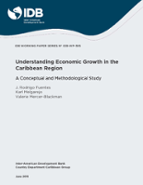Understanding Economic Growth in the Caribbean Region: A Conceptual and Methodological Study
Date
Jun 2015
A renewed interest in explaining growth in the Caribbean countries is motivated by the somewhat slow but uneven performance in the past decade: per capita GDP gaps in Caribbean countries have widened in relation to the United States, whereas standard theories would predict convergence. This study (a) examines the question using methods developed in the recent growth literature on economic growth and (b) characterizes the main elements of growth by estimating empirical models. On the basis of time-series and comparative static estimations, the study finds that the combination of domestic policies, high indebtedness, and outside shocks (e.g., oil price changes or main trading partners' tourism demand) explain well the gap in growth of the six IDB member countries (The Bahamas, Barbados, Guyana, Jamaica, Suriname, and Trinidad and Tobago). Moreover, the study shows evidence that the member countries' small size and their synchronicity with the U.S. business cycle influenced growth performance. In general, the influence of good policies on growth is still evident from the analysis.




